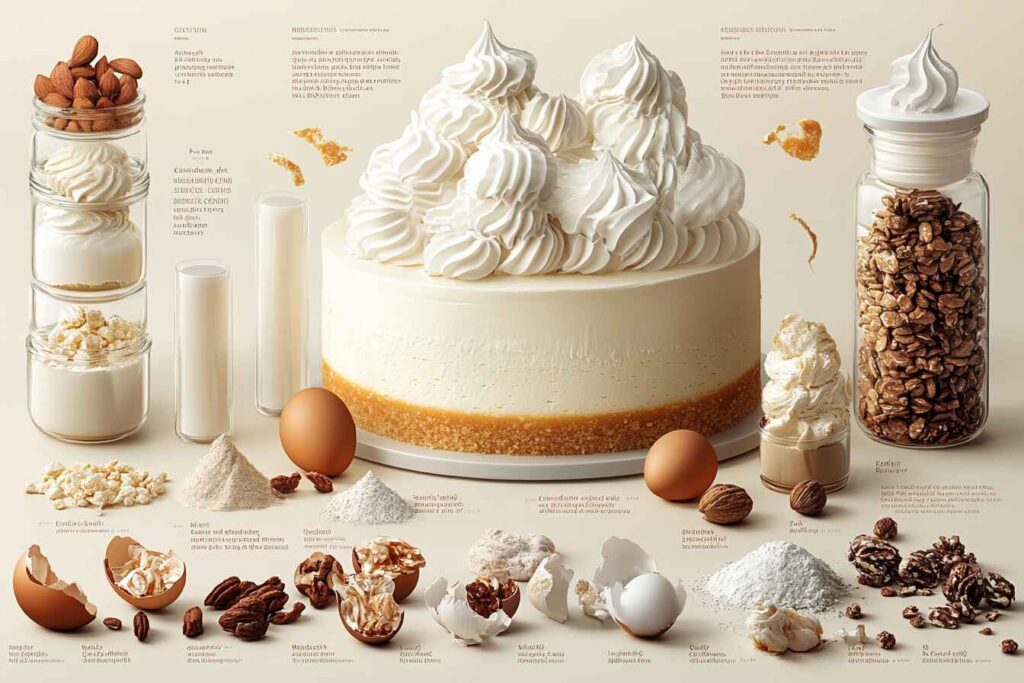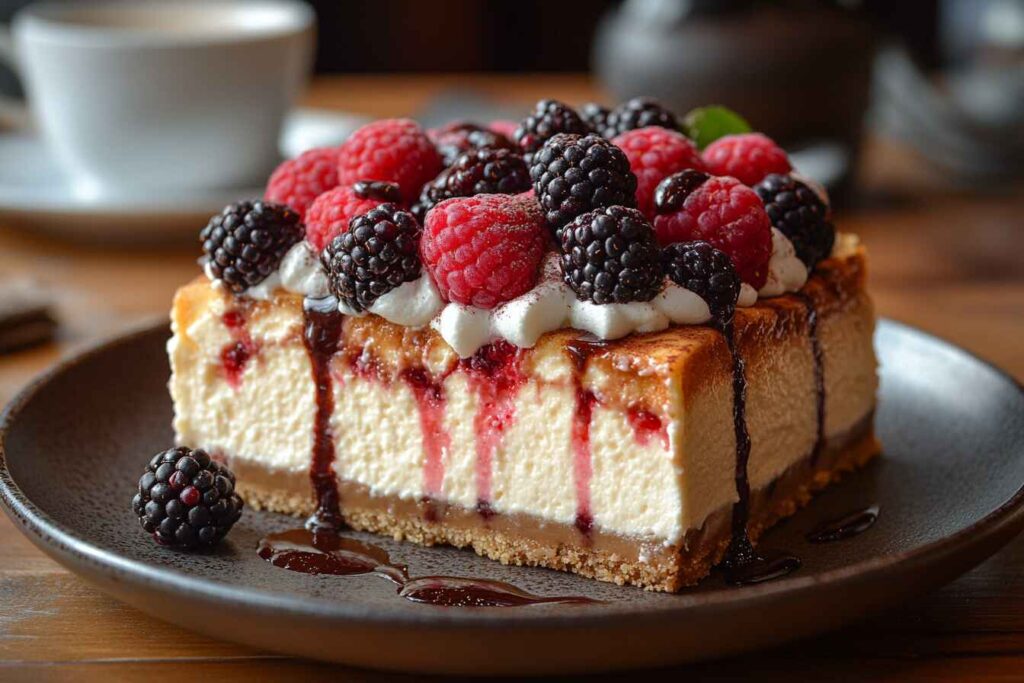Have you ever wondered, what is the thickening agent in cheesecake? That smooth, creamy texture doesn’t happen by accident! Whether it’s a baked or no-bake cheesecake, the secret to the perfect consistency lies in using the right thickening agent. From eggs and cream cheese to gelatin and cornstarch, these ingredients work behind the scenes to give cheesecake its rich, sliceable structure. In this guide, we’ll explore the different thickening agents, how they work, and expert tips to ensure your cheesecake turns out perfect every time!
Introduction to Cheesecake and Its Texture
Cheesecake is one of the most beloved desserts worldwide. Whether it’s rich and dense or light and fluffy, the texture of a cheesecake depends largely on the ingredients used. The key to getting that signature consistency? A thickening agent!
Think of cheesecake like a delicate balancing act. You want it to be firm enough to hold its shape when sliced but creamy enough to melt in your mouth. If your cheesecake turns out too runny or too dense, chances are you either used the wrong thickener or didn’t use it correctly.
Did you know? The word “cheesecake” dates back to ancient Greece! The first recorded recipe was written by the Greek writer Athenaeus in 230 AD.
Why is a Thickening Agent Needed in Cheesecake?
So, why do we even need a thickening agent in cheesecake? Simple—because without it, the filling wouldn’t set properly.
The Role of Thickening Agents in Cheesecake
- Structure: A thickening agent holds the cheesecake together, ensuring it doesn’t collapse.
- Texture: It determines whether your cheesecake is dense, airy, or silky smooth.
- Stability: Some cheesecakes need to hold their shape for hours at room temperature, and the right thickener helps with that.
Whether you’re making a baked cheesecake or a no-bake version, the thickening agent is what makes the filling firm enough to hold its shape when sliced.
Common Problems Due to Lack of Thickening Agents
If you’ve ever had a cheesecake fail, it was probably due to a missing or ineffective thickening agent. Here are some common problems:
- Runny Filling: If your cheesecake is too soft and doesn’t hold its shape, you likely didn’t use enough thickener.
- Cracked Top: Overbaking or using too much of a thickening agent (like cornstarch) can cause cracks.
- Gummy or Rubbery Texture: Some thickeners, like gelatin, can make a cheesecake overly firm if used incorrectly.
Now that we know why thickeners matter, let’s dive into the most common types used in cheesecakes.
The Most Common Thickening Agents in Cheesecake
There are several ways to thicken a cheesecake, and each ingredient plays a unique role. Let’s take a closer look at the most popular options.

Cream Cheese: The Primary Thickening Agent
Cream cheese is the star ingredient in most cheesecakes. It provides the rich, tangy flavor and firm texture we all love.
| Ingredient | Function |
|---|---|
| Cream Cheese | Gives structure and creaminess |
High-quality, full-fat cream cheese is best for cheesecake. Avoid low-fat versions, as they contain more water and can make the cheesecake too soft.
Eggs: A Natural Binder and Thickener
For baked cheesecakes, eggs are the unsung hero. They provide structure and help the cheesecake set as it bakes.
Baking Tip: Always add eggs one at a time and mix on low speed to prevent overbeating, which can cause cracks.
Gelatin: A Stabilizer for No-Bake Cheesecakes
If you’re making a no-bake cheesecake, gelatin is your best friend. It helps the filling set without the need for baking.
| Ingredient | Best for |
|---|---|
| Gelatin | No-bake cheesecakes |
To use gelatin, dissolve it in warm water before adding it to your filling. This prevents lumps and ensures an even texture.
Cornstarch and Flour: Thickening Baked Cheesecakes
Many bakers use cornstarch or flour to prevent cracks and add extra firmness to baked cheesecakes.
Pro Tip: If using cornstarch, mix it with sugar before adding it to avoid clumping.
Sour Cream and Greek Yogurt: Enhancing Thickness and Creaminess
Some cheesecakes use sour cream or Greek yogurt to add a slight tanginess and improve the creamy texture.
- Sour Cream: Makes the cheesecake softer and slightly tangy.
- Greek Yogurt: A healthier alternative that adds protein.
Heavy Cream and Whipping Cream: Adding Richness and Structure
Heavy cream is often added to cheesecake fillings to create a silkier, more luxurious texture.
Fun Fact: Whipping the cream before folding it into the batter can make no-bake cheesecakes lighter and airier.
Comparing Thickening Agents: Pros and Cons
Now that we’ve covered the most common thickeners, let’s compare them side by side.
| Thickening Agent | Pros | Cons |
|---|---|---|
| Cream Cheese | Rich, creamy texture | Can be too soft without support |
| Eggs | Great for baked cheesecakes | Can cause cracks if overcooked |
| Gelatin | Perfect for no-bake cheesecakes | Can become rubbery if overused |
| Cornstarch | Prevents cracking | Can make texture too firm |
So, which thickener is best? It depends on the type of cheesecake you’re making. A classic baked cheesecake relies on eggs, while a no-bake version needs gelatin or whipped cream.
Common Problems with Cheesecake Texture and How to Fix Them
Even with the best ingredients, cheesecakes can sometimes go wrong. From runny fillings to cracked tops, let’s troubleshoot the most common cheesecake problems and find the best solutions.
Why is My Cheesecake Too Runny?
A runny cheesecake is one of the most frustrating issues bakers face. Here’s why it happens:
- Not Enough Thickening Agent: If you didn’t use enough eggs, gelatin, or cornstarch, your cheesecake won’t set properly.
- Underbaking: Cheesecakes need time to bake fully. If you remove it from the oven too soon, it will stay soft in the center.
- Skipping the Chilling Time: Cheesecake needs several hours in the fridge to set properly. Rushing this step leads to a runny texture.
How to Fix It:
- If it’s already baked: Place the cheesecake back in the oven at 325°F (163°C) for 10-15 more minutes.
- If it’s a no-bake cheesecake: Mix in extra gelatin or refrigerate for at least 6 hours before serving.
Quick Tip: To test if your cheesecake is done, gently shake the pan. If only the center jiggles slightly, it’s ready!
How to Prevent Cheesecake from Cracking?
Cracks in a cheesecake don’t affect taste, but they can be disappointing if you’re aiming for a flawless look. Here’s what causes them:
- Overbaking: Cheesecakes should be slightly jiggly in the center when removed from the oven.
- Rapid Cooling: Sudden temperature changes cause cracks. Always let the cheesecake cool gradually.
- Overmixing: Mixing too much incorporates air, which expands and causes cracks.
How to Fix It:
- Cover cracks with toppings: Fresh fruit, chocolate ganache, or whipped cream can hide cracks beautifully.
- Use a water bath: Baking in a water bath keeps the oven’s temperature steady, reducing the chances of cracks.
Baking Hack: To make a water bath, wrap the cheesecake pan in foil, place it in a larger baking dish, and fill the dish with hot water.
Can I Fix a Runny Cheesecake After Baking?
If your cheesecake didn’t set properly after baking, don’t panic! Here are a few things you can try:
- Rebake It: Place it back in the oven at a low temperature (250°F/121°C) and bake for another 10-15 minutes.
- Freeze It: If it’s too soft, freezing for an hour before serving can help firm it up.
Expert Tips for Achieving the Perfect Cheesecake Texture
Now that we’ve covered common problems, let’s look at expert tips to get that perfect creamy texture.
Choosing the Right Ingredients
- Use Full-Fat Dairy: Low-fat alternatives contain more water, leading to a softer texture.
- Use Fresh Eggs: Old eggs don’t bind as well, affecting the thickness.
- Use the Right Sugar: Powdered sugar dissolves faster, while granulated sugar gives structure.
Pro Tip: Always use room temperature ingredients! Cold ingredients don’t mix well, causing lumps in the batter.
Mixing and Baking Techniques for a Firmer Texture
- Don’t Overmix: Overmixing adds air, making the cheesecake rise and then collapse.
- Bake at a Low Temperature: A slow bake at 300°F (150°C) prevents overcooking.
Cooling and Chilling Tips for the Best Results
- Cool Gradually: Turn off the oven and let the cheesecake sit inside with the door slightly open for an hour.
- Chill for at Least 6 Hours: The longer it chills, the better the texture.
Alternative Thickening Agents for Special Diets
If you need a cheesecake that’s vegan, gluten-free, or dairy-free, there are great alternatives.
Vegan Cheesecake: Using Agar-Agar or Cashews
- Agar-Agar: A plant-based thickener similar to gelatin.
- Cashews: Soaked cashews create a creamy base for dairy-free cheesecakes.
Gluten-Free Thickening Agents: Tapioca and Arrowroot Powder
For gluten-free cheesecakes, swap out cornstarch with these options:
- Tapioca Starch: Works similarly to cornstarch but is gluten-free.
- Arrowroot Powder: Helps firm up the filling without altering flavor.
Dairy-Free Substitutes for Thickening Cheesecake
If you’re avoiding dairy, try these substitutes:
- Coconut Cream: Thick and rich, perfect for no-bake cheesecakes.
- Almond Milk + Cornstarch: A great substitute for traditional milk-based thickeners.
Did You Know? Agar-agar sets firmer than gelatin, so you need to use half the amount in recipes!
FAQs About Cheesecake Thickening Agents
Gelatin is the best choice, but agar-agar works for a vegan version.
2. Can I use cornstarch instead of eggs in a cheesecake?
Yes! Cornstarch can be used as an egg substitute, but it slightly alters the texture.
3. How do I prevent my cheesecake from being too soft?
Ensure you’re using the right amount of thickener and chilling for at least 6 hours.
4. What can I use instead of cream cheese for a dairy-free cheesecake?
Cashews, coconut cream, or dairy-free cream cheese are great alternatives.
5. Can I fix an undercooked cheesecake?
Yes! Rebake at a low temperature or chill it longer to firm up.
Baking Challenge: Try making a cheesecake using different thickening agents and see which one you like best!
- Use the right thickener for your cheesecake type.
- Pay attention to baking time and cooling methods.
- Experiment with different thickening agents to find what works best for you!
Ready to take your cheesecake game to the next level? Try out these tips in your next recipe and enjoy a flawless, creamy dessert every time!
Final Pro Tips for Making the Perfect Cheesecake
Now that we’ve covered the science of thickening agents and troubleshooting common cheesecake problems, let’s round things out with some expert tips to make sure every cheesecake you bake is a masterpiece.

1. Always Use Room Temperature Ingredients
One of the biggest mistakes people make is using cold ingredients straight from the fridge. Cream cheese, eggs, and sour cream should all be at room temperature to mix smoothly, creating a creamy, lump-free batter.
Quick Tip: Forgot to take out your cream cheese early? Microwave it for 15 seconds to soften it instantly!
2. Avoid Overmixing the Batter
Mixing too much incorporates air into the batter, leading to cracks and an uneven texture. Always mix on low speed and stop as soon as the ingredients are combined.
3. Bake Low and Slow
Baking at a lower temperature (around 300°F to 325°F) ensures even cooking and a silky-smooth texture. A sudden high temperature can cause the cheesecake to puff up and collapse, leading to cracks.
Baking Hack: If your oven runs hot, place a pan of water on the lower rack to add moisture and prevent overheating.
4. Always Chill Before Slicing
Resist the temptation to slice into your cheesecake too soon! It needs at least 6 hours in the refrigerator to fully set. For the best results, chill overnight.
5. Use a Sharp, Warm Knife for Clean Slices
Ever noticed how cheesecakes at bakeries have those perfect slices? The trick is using a sharp knife warmed in hot water. Wipe the knife clean between cuts for a flawless presentation.
Serving Tip: For extra indulgence, serve each slice with a drizzle of chocolate, caramel, or fresh fruit sauce.
Bonus: Best Cheesecake Recipe Using a Thickening Agent
Want to put everything you’ve learned into practice? Here’s a **foolproof cheesecake recipe** using thickening agents to create the perfect creamy texture.
Classic New York Cheesecake Recipe
| Ingredient | Quantity |
|---|---|
| Cream Cheese (Full-Fat) | 24 oz (680g) |
| Granulated Sugar | 1 cup (200g) |
| Eggs | 3 large |
| Sour Cream | 1 cup (240g) |
| Cornstarch | 2 tbsp |
| Vanilla Extract | 1 tsp |
| Butter (Melted) | 4 tbsp |
| Graham Crackers (Crushed) | 1 ½ cups |
Instructions:
- Prepare the Crust: Mix crushed graham crackers with melted butter and press into a springform pan.
- Mix the Filling: Beat cream cheese, sugar, and vanilla until smooth. Add eggs one at a time, mixing on low speed.
- Incorporate the Thickening Agent: Stir in cornstarch and sour cream until well combined.
- Bake: Pour into the crust and bake at 325°F (163°C) for 55-60 minutes.
- Cool and Chill: Let the cheesecake cool in the oven with the door slightly open, then refrigerate for at least 6 hours.
- Slice and Enjoy!
Serving Suggestion: Top with fresh berries, whipped cream, or a drizzle of chocolate sauce for an extra indulgent treat.
Final Thoughts: Master the Art of Cheesecake-Making
Now you know the secret to a perfectly thick and creamy cheesecake! Whether you’re using cream cheese, eggs, gelatin, cornstarch, or a dairy-free alternative, the right thickening agent makes all the difference.
Here’s a quick recap:
- Baked Cheesecake: Eggs and cornstarch work best for a firm, structured texture.
- No-Bake Cheesecake: Gelatin or whipped cream ensures a smooth, sliceable consistency.
- Vegan Cheesecake: Cashews, agar-agar, or coconut cream are great thickening alternatives.
By understanding the role of thickening agents, you can troubleshoot problems, experiment with flavors, and create cheesecakes that rival any bakery.
Challenge: Try making a cheesecake using a different thickening agent and see how it changes the texture!

